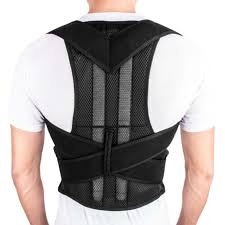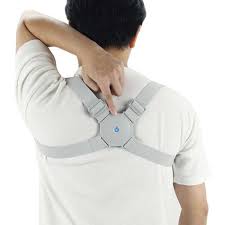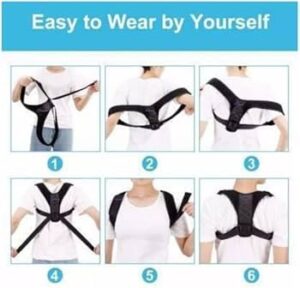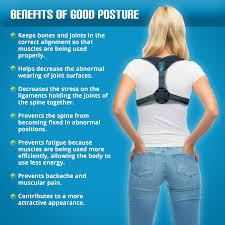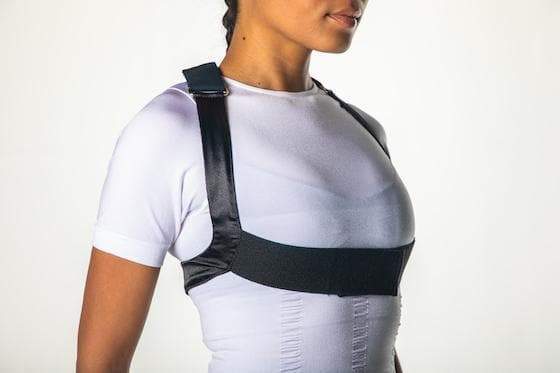

Posture correction devices are increasingly popular tools for improving alignment and alleviating pain caused by prolonged poor posture.
However, their effectiveness depends on correct usage.
In this article, BestForwardHeadPostureFix shall explore the importance of proper usage, how to fit a posture correction device, and tips to maximize its benefits.
By the end, you would understand not only how to wear these devices but also why proper technique is essential for your musculoskeletal health.
You also need to learn how to fix bad neck posture naturally.
Table of Contents
- Understanding Posture Correction Devices
- Why Proper Usage Matters
- How to Choose the Right Device
- Step-by-Step Guide to Wearing a Posture Correction Device
- Common Mistakes to Avoid
- Benefits of Wearing Posture Correction Devices Correctly
- Real-Life Examples of Improved Posture
- Scientific Backing for Posture Devices
Understanding Posture Correction Devices
Posture correction devices, or posture braces, are like your friendly reminder to “sit up straight!” but with a touch of engineering genius.
These clever contraptions typically feature adjustable straps and a supportive framework designed to coax your shoulders, neck, and upper back into proper alignment.
Think of them as a gentle nudge from a caring coach, encouraging your spine to stay neutral and your shoulders to sit comfortably back where they belong.
Far from being medieval torture devices, modern posture braces are sleek, functional, and surprisingly comfortable.
Whether you are battling hours hunched over a desk or wrestling with the infamous “tech neck,” these gadgets offer an easy way to hit the reset button on your alignment.
Wearing one isn ot just about looking poised; it is about giving your body the structural support it craves while making sure you stand tall—literally and figuratively.
Types of Posture Devices:
Posture correction devices come in various forms, each tailored to specific needs and levels of support.
Understanding their differences can help you choose the right one for your lifestyle and posture goals.
- Clavicle Braces: These are lightweight devices designed to support the upper back and shoulders. Perfect for individuals with rounded shoulders or mild posture issues, they gently pull the shoulders back to promote better alignment.
- Full Back Braces: Offering comprehensive support, these braces cover the thoracic spine, making them ideal for those dealing with more significant posture challenges or back pain. They provide structured reinforcement for the entire upper back, encouraging upright posture throughout the day.
- Electronic Posture Trainers: For the tech-savvy, these devices take correction to the next level. Equipped with sensors, posture tracking braces vibrate or beep when your posture deviates from the desired position, serving as real-time reminders to sit or stand tall.
Choosing the right device depends on the level of correction needed, comfort, and how seamlessly it integrates into your daily routine. Each type offers a unique approach to fostering better posture, so you can find the one that helps you align with ease and confidence.
Why Proper Usage Matters?
Wearing a posture correction device seems like a straightforward fix for slouching, but improper use can backfire spectacularly.
Instead of improving alignment, a poorly fitted device can cause muscle imbalances, exacerbate discomfort, or make you overly dependent on the brace, neglecting the muscles that support natural posture.
Key Considerations:
- Fit Matters: A brace that’s too tight can restrict circulation or limit movement, leaving you feeling more like a mummified superhero than a poised professional. On the flip side, a loose fit won’t provide the support you need.
- Overuse Pitfall: Relying on the device 24/7 can weaken your postural muscles, making them lazy. It is like outsourcing your spine’s job to a gadget.
- Proper Distribution: When used correctly, the device evenly distributes tension across your shoulders and back, enhancing support without straining specific areas.
A Real-World Analogy:
Imagine Bob, a desk warrior who wore his brace too tightly, thinking “the tighter, the better.” Within a week, he felt achy shoulders and had difficulty stretching. A quick adjustment to a snug-but-not-strangling fit worked wonders, improving his posture without discomfort.
Supporting Evidence:
A study in Clinical Biomechanics (Cagnie et al., 2005) revealed that properly used braces optimize muscle activation and reduce unnecessary strain on the spine. So, don’t let poor usage turn a posture solution into a posture problem!
How to Choose the Right Device?
When it comes to posture correction devices, the market is awash with options, but not all are suited to your specific needs.
Finding the right device is like shopping for shoes—it has to fit perfectly and serve its intended purpose.
Key Factors to Consider:
- Body Type Compatibility: Adjustable straps are a game-changer. They ensure that people of varying shapes and sizes can achieve a snug yet comfortable fit, avoiding the “too loose to help, too tight to breathe” dilemma.
- Level of Support: Not all braces offer the same degree of support. Lightweight braces are perfect for mild alignment issues, while full-support braces are better for severe postural problems or chronic pain.
- Material Matters: Breathable materials like neoprene or cotton blends are ideal for long-term use. They wick away sweat, reduce skin irritation, and make wearing the device a breeze—even during hot days.
- Define the Goal: Are you looking to relieve pain, improve alignment, or both? A lightweight, minimal brace may suffice for occasional posture reminders, while a full-back brace may be necessary for more significant corrections.
A Witty Example:
Sarah, a yoga enthusiast, bought a rigid brace for her mild slouch. Unsurprisingly, it felt like wearing medieval armor.
A switch to a soft, breathable option solved her issues, letting her align her posture without sacrificing comfort.
Step-by-Step Guide to Wearing a Posture Correction Device
While wearing a posture correction device seems simple, ensuring it fits and functions properly requires precision.
Here is how to make the most of your device without causing discomfort or muscle strain.
Step 1: Adjust the Straps
Before putting it on, loosen the straps to make the device easier to wear. Place it over your shoulders like a backpack, ensuring the straps lie flat and don’t twist, as twisted straps can create uneven tension.
Step 2: Position the Back Pad
Align the back pad so it sits along your thoracic spine, typically between the shoulder blades. Proper placement ensures the device supports the correct area, gently encouraging your shoulders to move back.
Step 3: Secure the Device
Tighten the straps gradually, aiming for a supportive pull without causing discomfort. The goal is alignment, not restriction, so avoid overtightening.
Step 4: Check Your Alignment
Stand in front of a mirror and evaluate your posture. Your head, shoulders, and spine should form a straight line. Ensure your chin is level, and your shoulders aren’t raised unnaturally by the straps.
Step 5: Start Slow and Build
Begin with short sessions—15 to 20 minutes daily—and increase the duration as your body adapts to the correction.
Jessica’s Example:
Jessica, a 32-year-old office worker, struggled with shoulder pain from slouching. By following these steps, she noticed an improvement in her posture and significant pain relief within four weeks, proving the value of proper use.
Common Mistakes to Avoid
While posture correction devices can be highly effective, improper use can hinder their benefits and even cause additional issues. Many users unknowingly make mistakes that reduce the device’s effectiveness and create unnecessary discomfort.
Frequent Mistakes:
- Over-Tightening Straps: Tightening straps too much can restrict circulation, cause discomfort, and create pressure points. A properly fitted brace should feel supportive, not constrictive.
- Wearing for Too Long: Extended use of a posture correction device can lead to muscle dependency. Instead of strengthening your postural muscles, overuse weakens them, delaying long-term progress.
- Incorrect Sizing: A brace that’s too loose won’t provide adequate support, while one that’s too tight can limit movement and cause irritation. Always choose a device that fits your body size and shape correctly.
- Neglecting Exercise: Posture devices are not standalone solutions. Relying solely on the brace without incorporating strengthening exercises such as lat pulldowns for the back, core, and shoulders slows progress and reduces the overall benefits.
Tom’s Example:
Tom, a 28-year-old programmer, initially over-tightened his brace and wore it for several hours daily.
This led to discomfort and reduced muscle strength. After correcting these mistakes and integrating targeted exercises, he experienced improved posture and reduced shoulder tension within six weeks.
Benefits of Wearing Posture Correction Devices Correctly
Using a posture correction device properly can deliver numerous physical, psychological, and long-term benefits.
When worn as intended, these devices become effective tools for improving overall alignment and reducing pain.
Improved Postural Awareness
One of the primary benefits of posture correction devices is their ability to heighten awareness of body alignment.
Regular use encourages better posture habits, training your body to maintain an upright position even when the device is not worn.
Over time, this fosters a natural, sustainable improvement in posture.
Pain Relief
Posture braces are particularly effective in alleviating chronic pain associated with poor posture, such as neck, shoulder, and upper back muscle stiffness.
By redistributing the load across the spine and reducing muscular strain, these devices provide relief for conditions like tension headaches and cervical spine issues.
Enhanced Confidence
Standing taller not only improves physical alignment but also enhances self-esteem and non-verbal communication. A study published in Psychological Science (Carney et al., 2010) found that upright posture positively influences mood and confidence, empowering individuals in social and professional settings.
Improved Muscle Engagement
When used correctly, posture devices encourage engagement of postural muscles like the core and back extensors. This helps to strengthen these muscles over time, reducing the likelihood of posture-related injuries or pain.
Prevention of Long-Term Issues
Correct use of these devices can prevent the progression of postural deformities, such as kyphosis or forward head posture, which may lead to severe spinal complications in the future.
John’s Journey to Shoulder Comfort
John, a 45-year-old teacher, struggled with persistent shoulder pain due to years of poor posture while standing and lecturing.
His forward-slouched position placed unnecessary strain on his upper back and shoulders. After incorporating a posture correction device into his routine, he noticed an immediate improvement in his posture.
By pairing the brace with targeted upper back and core-strengthening exercises (such as deadlift and rows), John experienced significant relief within weeks.
The device served as a constant reminder to maintain proper alignment, allowing him to teach for longer periods without discomfort.
Maria’s Desk Job Transformation
Maria, a 28-year-old graphic designer, spent hours hunched over her computer, leading to “tech neck” and frequent tension headaches.
Seeking a solution, she began using a posture correction device designed to realign her shoulders and reduce neck strain.
Over the course of three months, Maria integrated short daily posture checks and adjusted her workstation ergonomics alongside the brace.
Not only did her headaches subside, but her overall productivity increased as she felt less fatigue throughout the day.
The posture device became a cornerstone in her approach to achieving a healthier, more comfortable work routine.
Scientific Backing for Posture Devices
Numerous studies have highlighted the benefits of posture correction devices:
- Griegel-Morris et al., 1992 (Clinical Biomechanics): This research demonstrated that improving posture through devices effectively reduces musculoskeletal strain in individuals with sedentary lifestyles, showcasing their role in pain prevention.
- Cagnie et al., 2005 (Journal of Electromyography and Kinesiology): Found that posture braces promote upper back muscle activation, enhancing support and reducing fatigue in the back and shoulders.
- Lau et al., 2010 (The Spine Journal): Confirmed that combining posture correction devices with physical therapy alleviates chronic pain and improves spinal alignment, emphasizing their efficacy in therapeutic settings.
These studies collectively validate the practical benefits of using posture correction devices correctly.
Conclusion
Wearing a posture correction device correctly is crucial to unlocking its full benefits.
When used properly, these devices promote better alignment, reduce strain on the neck and shoulders, and alleviate chronic discomfort caused by poor posture.
The key lies in understanding how to position and adjust the device for your body, avoiding common pitfalls such as over-tightening or overuse.
Combining proper device usage with posture awareness and targeted strengthening exercises enhances long-term results.
Scientific research, such as studies in Clinical Biomechanics and The Spine Journal, supports their efficacy in reducing musculoskeletal strain.
Real-life success stories, from desk workers to athletes, highlight how these tools transform posture and improve quality of life.
Whether battling “tech neck” or striving for better alignment, posture correction devices offer a practical and scientifically backed solution for better musculoskeletal health.
References:
